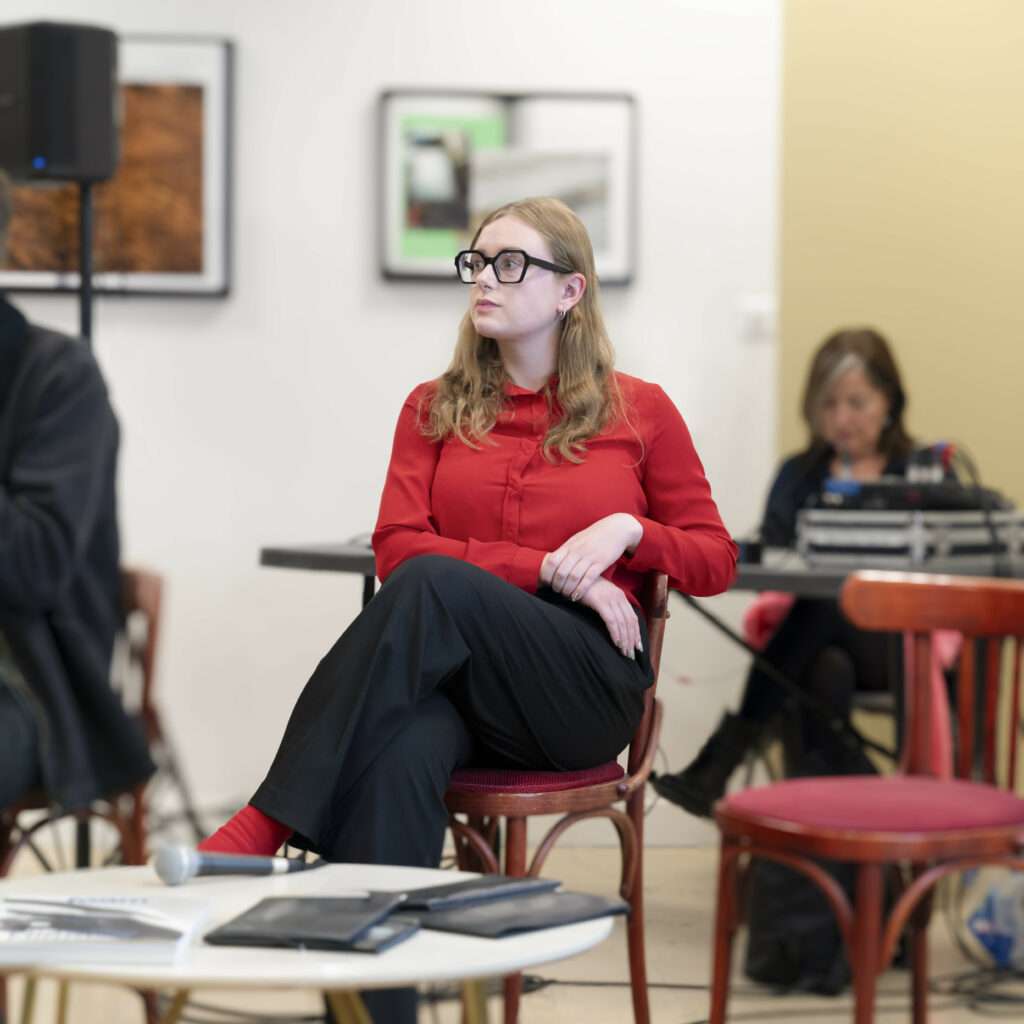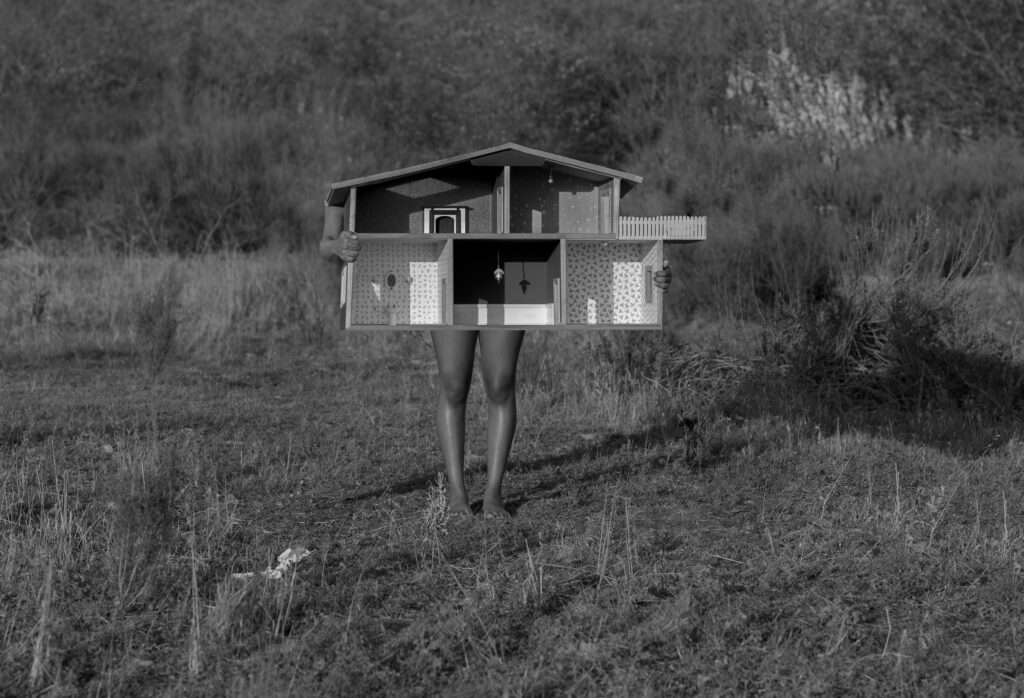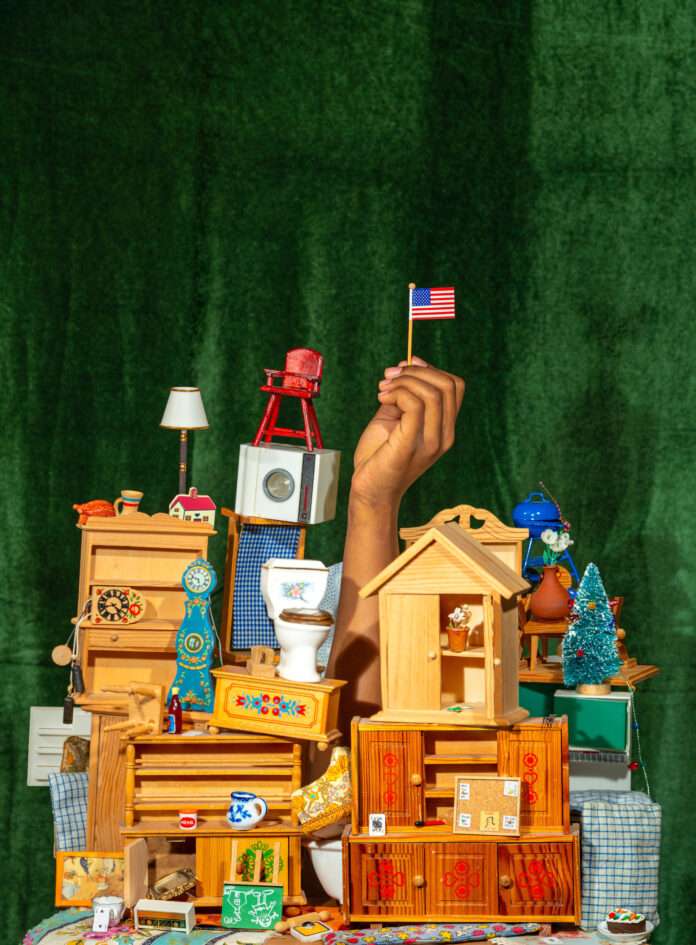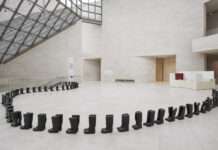Francesca Hummler, Victory, 2021 (Our dollhouse),courtesy of the artist
« Our Dollhouse », a series by Francesca Hummler, stands out as one of the revelations of Photaumnales 2025, curated by Emmanuelle Halkin, on view at Beauvais ‘station park with other photographers.
For over thirteen years, Francesca has photographed her younger sister, according to her legitimate pain not to be part of the entire family’s memory prior to her adoption.
Born ten years apart, the sisters grew up in a German-American household in the United States. Supporting her sister in building self-confidence and exploring her identity as a young Black girl within a multicultural family context became a photo-therapy.
A central motif in the series is a dollhouse, originally crafted by their great-grandfather and later completed by their grandparents. Together, the sisters have filled it with heirlooms passed down through generations. This collaborative act becomes a symbolic gesture of inclusion and transmission. A very intimate body of work on intergenerational belongings.
Our dollhouse is also actually part of « Gen Z. Shaping a New Gaze » collective show at Photo Elysée, Lausanne.
Francesca Hummler (born in 1997 in New York) is a German-American visual artist and researcher. Drawing on her experience as the daughter of German immigrants, she explores notions of identity, family intimacy, and intergenerational trauma. Influenced by phototherapy, she uses self-portraiture and collaborates with others in her artistic practice. Her work has been shown in venues such as Paris Photo and the Sprengel Museum.

Francesca Hummler credit Amin Yousefi
Had you heard of the Photaumnales before taking part?
Yes, I had. A few of my friends, including Daniel Szalai and Alice Pallot, showcased their work in last year’s edition. To me, that is one of the most precious parts of the photography community, the way we continue to encounter each other across different countries and contexts.

Francesca Hummler, All Her Own 2021 (Our dollhouse),courtesy of the artist
Did you choose the location of your exhibition ? How do you feel about showing your work in « Parc de la gare » with other artists ?
No, the Photaumnales team and curator Emmanuelle Halkin chose the location for my work. I really loved the display. Showing the series along the main promenade in the park created such a unique experience and a sense of openness. It is a privilege to present my work alongside such a diversity of projects connected by a unifying theme. Emmanuelle is a very talented curator who takes great care to ensure the work is displayed in the best possible way. I feel she truly understands why I make images, and her support means the world to me. She is also an incredibly warm person, and you could sense her care in the way the artists were chosen. All of them were approachable, generous, and open to conversation about their projects, which made the experience even more special.
You’re presenting Our Dollhouse. What does this dollhouse symbolize in your artistic practice ?
The construction of the dollhouse was begun by my great-grandfather, and as he worked in a noodle factory, the first floor was actually made from old wooden noodle crates. For me, the dollhouse is a real family heirloom. My grandfather, who continued building it, passed away two years ago. He was a German teacher and always told me stories about our family, his childhood, the Swabian dialect, and the Second World War.
Now that he’s gone, I see it as my responsibility to keep our family’s memories and stories alive. That feels even more important because my parents don’t have much connection to German culture or language. My sister Katherine is currently taking German classes, and the two of us are trying to keep that part of our heritage alive, especially if we have children of our own someday.The dollhouse has also been a way for our family to talk about difficult subjects. It’s both a stage and a metaphorical space where, by posing Masantu within it like a giant figure, we reflect on her arrival into our family. For me, it’s important because it symbolizes celebrating my family’s process of finding our cultural identity, and this project was also the first time I applied the therapeutic approach of my photography, something I had previously used only in my self-portraits, to the story of my family.
Let’s take a closer look at the image Der Stammbaum or The Family Tree. How does this photograph capture the essence of what you and your sister Masantu set out to express ?
In Der Stammbaum (The Family Tree), Masantu hangs her own black-and-white portrait on the dollhouse’s “family tree” wall, right alongside images from our family archive. Some of the portraits go back more than a century, like our paternal great-grandfather Johann Hummler photographed in 1917 before the end of World War I, and even further to his mother’s parents in 1860. The Hummler family kept meticulous records, partly because of Nazi Germany’s requirements for lineage documentation like the Ahnenpaß. It is a dark history that now allows us to trace our family back as far as 1680, with each photograph carefully annotated with names, birth dates, and places.
In the image, Masantu holds a portrait of herself, where she also wears my confirmation dress. In a kind of inception-like gesture, Masantu holds a portrait of our maternal great-grandmother Paula Banzhaf. In that portrait, Paula wears a string of pearls, while Masantu herself, in the act of holding the image, wears a silver Ethiopian cross. The traditions of these churches are different, and my family was never able to trace which church Masantu’s biological family belonged to, but the pairing of these images says a lot.
For me, this photograph encapsulates what we set out to express: that Masantu has a rightful claim to our family’s memory and history, and that we are building the future together. It is a visual of the family welcoming and supporting her, of her place within a lineage that stretches both backwards and forwards. I love layering “Easter eggs” into my images, objects, gestures, or symbols that carry stories only my family and I might fully recognize. They may just appear as details, but for us, they function much like a family album, confirming our history and reminding us why we are here now.
In your series Rituals, you explore both the weight of religious constraints and the liberating potential of photography. How did the self-portrait with blood in your eye become a pivotal moment for you ?
This photograph, And Jesus Wept, was the first in my Rituals series, though I did not realise it at the time. It is a self-portrait with blood dripping from my right eye, referencing Jesus sweating blood in the Garden of Gethsemane before the crucifixion. For me, the image captures the conflict I felt as a teenager between my faith and the church’s grip on my sexuality. Growing up in a Protestant household, my bisexuality was treated as a contradiction to the “purity” I was meant to embody as a woman. The blood is not only about suffering, it is about the pain of hiding who I am.
Through therapeutic photography, I confront the shame and constraints I was raised with. I still believe in God, but not in the God handed to me by the church, the one who demanded I erase myself. Photography gives me a way to push back, to reshape the symbols that once oppressed me. My Commandments of Self-Portraiture, like Thou shalt not curse thy own truthor Honour and cherish love in all forms, remind me to reclaim faith on my own terms.Aesthetically, Rituals has darker tones than my earlier, more whimsical projects. There is an underlying rage, a shift away from the domestic toward the so-called house of God. I use gestures that place what does not “belong” inside sacred space, such as hiding under the altar cloth, to turn the sacred on its head. This mirrors how faith lingers even when scripture blurs, much like the generational memories I have explored in other projects. In many ways, this is the first body of work where I speak plainly from my own biography, addressing gender and sexuality directly rather than through family members. And Jesus Wept became a turning point because it allowed me to face that history and reimagine it as devotion instead of shame.
As the daughter of German immigrants in the United States, how does the question of transgenerational identity inform and shape your work?
My identity as a first-generation American is inseparable from my work. My parents moved from the Stuttgart region to the U.S. in 1994, where my sister and I were born. In 2010, my youngest sister, Masantu, joined our family through adoption from Ethiopia. Growing up in a binational household, often distanced from extended family and German culture, gave me an acute awareness of how migration shapes identity.
Photography, in this context, became a way to bridge the distance between geographical locations and to study different facets of my identity. My practice extends from this point, exploring how archives, storytelling, and staged portraiture can carry forward fragile family histories while also challenging who gets to be represented.
This extends to projects like Das Kuckucksei (Cuckoo’s Egg), made in my grandparents’ home in Plüderhausen, Germany. Through photographic sessions and conversations with them, I uncovered stories of war, displacement, conservative belief systems, and family dynamics that shaped not only their lives but also my mother’s, and, by inheritance, my own. This reaffirmed my belief that trauma lives on in the body rather than only in the archive. My work resonates with Marianne Hirsch’s concept of postmemory, the idea that the “generation after” bears the cultural trauma of those before them.
In many ways, photography is how I preserve, reinterpret, and sometimes even repair the threads of identity across generations, while also acknowledging the fractures and chance encounters that have defined my family’s formation.
Last question, you graduated from the Royal College of Art in London, how do you look back on those years ?
I really valued my time in graduate school. The people I met at the RCA pushed me to take my artistic practice more seriously, and I’m still in close touch with many of my classmates. I think it is a real loss that the program has since been cut down to one year, because having that extended time was so formative for me. I feel privileged to have had the experience of attending, especially knowing that I paid for my education by saving money working as a bus driver and in a chemistry lab during Covid.
Writing my dissertation was a turning point. It clarified my practice and gave me the vocabulary to understand my impulse to make images. I focused on integrating the practices of artists like Jo Spence and Rosy Martin, and it felt like a full circle moment when I recently had lunch with Rosy in London.
London was never a place I imagined myself living, but the art scene there is unmatched. While I rarely made work in London itself, most of my projects were created while traveling or at home with my family. The RCA gave me the foundation and momentum to build a sustainable practice for the future.
More about the artist :
Practical Infos :
22nd edition
« To reside » / « Habiter »
Map
Until : December, 31, 2025
« Gen Z. Shaping a New Gaze »
Photo Elysée
https://elysee.ch/expositions/gen-z


![ART [ ] COLLECTOR, 20ème édition : Exposition de Caroline Corbasson, Lauréate](https://fomo-vox.com/wp-content/uploads/2025/12/Caroline-Corbasson_Poem-Painting-diptyque_2025_Encre-et-graphite-sur-toile_110-x-90-cm-chaque_©-Caroline-Corbasson_Photo-Nicolas-Brasseur_Courtesy-Dilecta-218x150.jpg)


![ART [ ] COLLECTOR, 20ème édition : Exposition de Caroline Corbasson, Lauréate](https://fomo-vox.com/wp-content/uploads/2025/12/Caroline-Corbasson_Poem-Painting-diptyque_2025_Encre-et-graphite-sur-toile_110-x-90-cm-chaque_©-Caroline-Corbasson_Photo-Nicolas-Brasseur_Courtesy-Dilecta-324x235.jpg)


